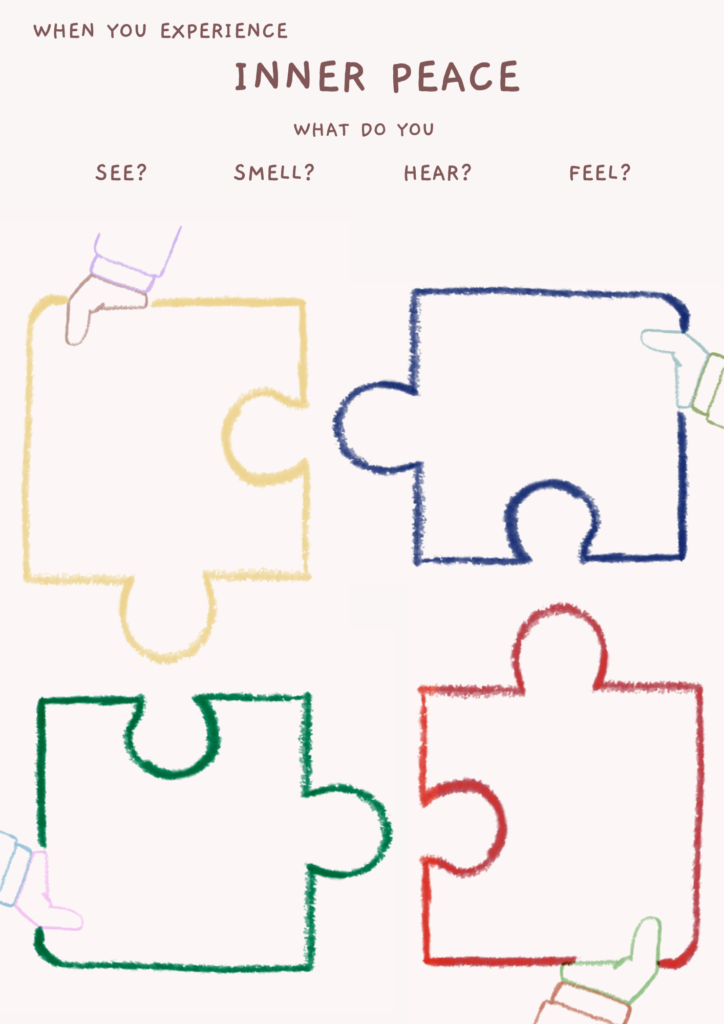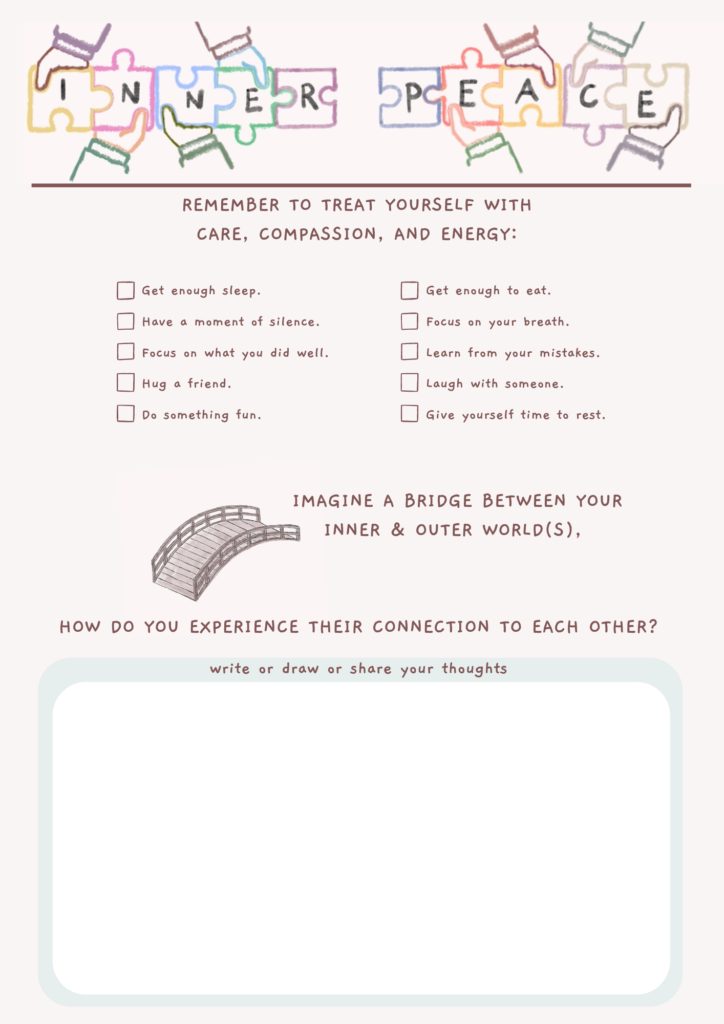Mindfulness is the energy that allows us to look deeply at our body, feelings, perceptions, mental formations, and consciousness, and see clearly what our real needs are, so we will not drown in the sea of suffering. Eventually love fills our mind and our will, and all our actions from that time on manifest love.
Thich Nhat Hanh, 1998[i]
This entry builds on my prior research on inner peace that turned into three entries already featured in this museum: Inner peace; and Om Shanti – an invocation for peace – ॐ शान्तिः ; and Mindful peace with Haemin Sunim. Its title is inspired by the fascinating work of Roxani Krystalli and Philipp Schulz, who have been encouraging scholars to take love and care seriously in International Relations.[ii] My goal is to generate more conversation about how loving, caring and compassionate practices can be brought into school settings, particularly in the context of peace education, which my wider team is researching. I am especially keen to examine whether children engage with inner peace in their classrooms; how they experience inner peace; and what connections, if any, they make between inner peace and peace in the wider world.
In another entry, I have shared how disheartening it is to witness friends and family members struggle with depressive, anxious, or negative emotions. An individual’s negative emotions can powerfully affect them, and they can also spill out into the world around them. The same is true of more positive emotions, and of practices of self-care and compassion. I believe that every step towards a society that seriously considers self-love and self-care is essential not only in promoting personal wellbeing but also in building and sustaining a peaceful future for us all. At the heart of my research is an understanding that inner peace, peace in our local communities and geopolitical peace and deeply connected.
Inner peace in a classroom?
Firstly, a defintion of ‘inner peace’ is necessary. Inner peace can be understood in about as many ways as there are people thinking of what peace is to them. Just take a moment to imagine what peace looks like to you. Do your images vary from mine? The answer is possibly ‘yes’. Rather than pinning down any concrete definitions, research indicates that it is helpful to think of inner peace as an outcome of mindful awareness practices. This definition allows for our individual imagery of peace to vary and impact us in different ways, while retaining an understanding of inner peace as something that we can all achieve. Furthermore, it brings the term into an applicable practice whose effects can be evaluated, building on existing research.[iii]
In the educational sector, emerging research suggests that taking self-love and self-care seriously is foundational to building an environment for children to learn and thrive in. The connection between self-love and inner peace here echoes the relation drawn by other scholars for other contexts. Simply put, self-loving practices often release endorphins and enhance serotonin in the brain, brining one to a happier state of mind. In turn, this supports one’s inner feelings of peace and satisfaction, which makes for a positive learning atmosphere (for recent studies, see Schonert-Reichl and Roeser, 2016). Therefore, the act of taking self-love and self-care seriously holds promise in any educational setting; and it has particular potential when aspiring to meaningful conversations about peace in classrooms. It is particularly with a view to enhancing peace education generally that I am keen to explore what time teachers are able to make to work with inner peace in their classrooms. Crucially, we must consider why, how, and for whom we intend to bring inner peace into classrooms.
No thanks to ‘well-being’ scented candles
Research into how we can enhance the mental well-being of children and adults has increased in the recent years, with lots of (sometimes problematic) emphasis on self-care.[iv] As you might recognise, the dominant discourse (in the West) often steers us towards buying self-help books, ‘well-being’ scented candles, and expensive yoga retreats. A deeper discussion of this exceeds my remit here, but it leads me to ask important questions about why, how, and for whom we might bring inner peace into classrooms.
In conversation with other researchers, I have discussed a concern that self-help training, inner resilience building and mindfulness teaching in the school setting can sometimes be incorporated into curricula in ways that encourage children not to find inner peace but rather to build inner resilience in solitude. While having many obvious benefits, ‘growth mindset’ and mindfulness lessons can put the onus on children to solve their own challenges. In a nutshell, this kind of approach can end up suggesting that, if children do not feel at peace, it is down to them: a failing on their part to practice sufficient mindfulness or resilience techniques. This is clearly not a desirable outcome.
As counter-intuitive as this may seem, an essential aspect of self-care is that it cannot be done alone. Instead, self-love flourishes best from a compassionate community, when practices of care for others and self-care are mutually supportive. Taking love and care seriously in the classroom setting involves establishing systems and structures which create links between mindfulness, self-awareness, self-compassion and inner peace, on the one hand, and caring, compassionate and peaceful interactions with others. The connection between inner and outer peace is strong.
Classroom resources


With all this in mind, I have created some worksheets for use in a primary school setting that build on existing research on mindfulness in classrooms. My aim with the worksheets is to start conversations between pupils and teachers about our distinct and personal connections to peace, and how nurturing inner peace can build bridges to wider peace-building.
In hoping for a peaceful future, where we can relax, breathe, reflect, and enjoy our lives, it is essential to explore what it might feel like with our senses. For this reason, the first worksheet (on the left) invites participants to visualise peace within oneself. When thinking of inner peace, what do you: See? Smell? Hear? Feel? Being able to sense and recognise manifestations of inner peace is a crucial step not only in learning to value and enjoy it but also in learning how to generate and reproduce it. Conversation through circle time about the different ways in which people see/smell/hear/feel inner peace can be helpful in thinking through how to nurture it in others as well as in appreciating how diverse we all are.
The second worksheet (above right) then prompts pupils and teachers to consider what connections exist between our inner and outer world(s). What external conditions can nourish inner peace? How does the outer world impact on your inner feelings? And how might your inner world influence your outer world? The ten prompts are offered as a friendly reminder to treat ourselves (and others) with compassion, and in alignment with these I ask; how do we experience the world when taking self-care seriously? Does the world appear more caring to us? Does the treatment of ourselves impact how we understand the world? And can our self-care have benefits also to others?
In guidance notes to teachers, I encourage them to set up each session so that pupils start by reflecting, writing or drawing on these pages either individually or in small groups. This is followed by a short mindfulness exercise, and then by some circle time, where the teacher encourages a free-flowing conversation about inner peace (how it can be felt, and how it can be generated) and its relation to the outer world. The aim is to generate inclusive conversations which promote more conscious practices of self-care, care for others and peace-building (inner and outer) in future. You can download the full resource below.
While recognising that our emotions and thoughts constantly change, I believe that in aiming for long-lasting peace within ourselves and within our wider communities, it is crucial to notice, understand and nourish our inner peaceful thoughts. This entry aims to help both normalise and embed such conversations into the classroom setting. The long-sighted goal is bring this research into the realm of geo-politics, hoping for a world that continuously takes love and care seriously.
What do you think?
- When you experience inner peace, what do you See? Smell? Hear? Feel?
- In what ways do you practice self-care and self-compassion in your daily life?
- Do you see a link between how peaceful you feel inside and how you experience peace in the wider world?
- Have you engaged with inner peace or mindfulness practices during your own education?
- What approaches to inner peace education and mindfulness should we promote in school settings?
- Do you think that teaching about inner peace can help educate young people about peace in the world?
- Do you think that schools could or should make more connections between inner peace and geopolitical peace?
If you enjoyed this entry in the museum…
You might enjoy ‘The Power of Comics‘, ‘I love you‘, and other items with the tags ‘children’, ‘care’, and ‘inner peace’.
Otilia Meden, December 2022
[i]Hahn, Thich Nhat. 1998. Teachings on love. 1st edition. California: Parallax Press
[ii]Krystalli, Roxani and Philipp Schulz. 2022. “Taking Love and Care Seriously: An Emergent Research Agenda for Remaking Worlds in the Wake of Violence” in International Studies Review 24 (1): 1-25.https://academic.oup.com/isr/article/24/1/viac003/6527435
[iii] Young, Shinzen. 2006. Break Through Pain: A Step-by-step Mindfulness Meditation Program for Transforming Chronic and Acute Pain. 1st edition. Boulder Colorado: Sounds True.
Lozar-Glenn, Joanne M. 2010. “The Teenage Brain: Think Silly Putty, Not Stone” from: The Garrison Institute: Bringing Mindfulness to Education. In Buisness Education Forum. http://joannelozarglenn.wtwpwn.com/wp-content/uploads/2011/04/9TeenageBrain_Feature_BS_Apr2010.pdf
[iv]Schonert-Reichl, Kimberly, and Roeser, Robert W. 2016. “Mindfulness in Education: Introduction and Overview of the Handbook.” In Handbook of Mindfulness in Education: Integrating Theory and Research into Practice edited by Kimberly A. Schonert-Reichl and Robert W. Roeser, 3-17, 1st edition. New York: Springer-Verlag
Links to other studies and projects on mindfulness and inner peace: